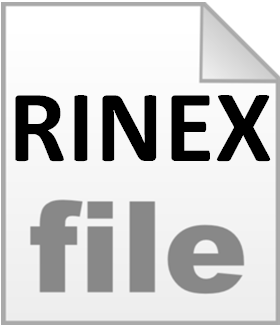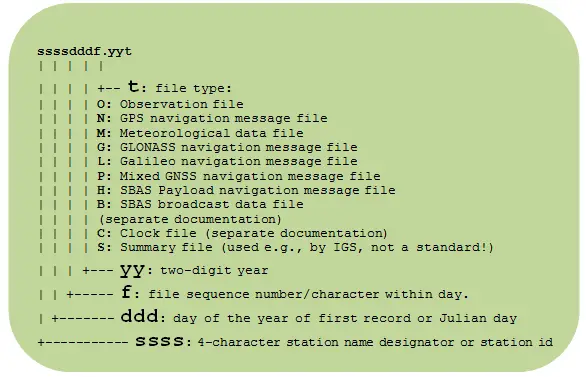 The first requirement for having a receiver independent exchange format arisen for easy exchange of the GPS data to be collected during the first large European GPS campaign EUREF 89, which involved more than 60 GPS receivers of 4 different makes. The proposal for RINEX was developed by the Astronomical Institute of the University of Berne, Switzerland.
The first requirement for having a receiver independent exchange format arisen for easy exchange of the GPS data to be collected during the first large European GPS campaign EUREF 89, which involved more than 60 GPS receivers of 4 different makes. The proposal for RINEX was developed by the Astronomical Institute of the University of Berne, Switzerland.
Since every manufacture is having its own proprietary output file format of GPS data collected. For example Trimble have .DAT, T01, T02 as output file extension.
A GPS signal consist of two carrier waves (L1 and L2) modulated with C/A code, P or Y code, navigation message. L1 carrier waves (frequency 1575.42 MHz, wavelength 19 cm) is modulated by C/A code, P or Y code and navigation message. L2 carrier waves (frequency 12.27 MHz, wavelength 24 cm) is modulated by P or Y code and navigation message.
The GPS data in RINEX file format is universal acceptable as it is a receiver independent file format.
RINEX file is an ASCII file format. The file structure of a RINEX file is as follows:

Example: 04843350.13o(Observation file) and 04843350.13n(Navigation file)
Up till now two major RINEX format versions have been developed:
The RINEX version 3.00 format consists of three ASCII file types:
Each file type consists of a header section and a data section. The header section contains global information for the entire file and is placed at the beginning of the file. The header section contains header labels in columns 61-80 for each line contained in the header section.
Each Observation file and each Meteorological Data file basically contain the data from one site and one session. Starting with Version 2 RINEX also allows to include observation data from more than one site subsequently occupied by a roving receiver in rapid static or kinematic applications. Although Version 2 and higher allow to insert header records into the data field it is not recommended to concatenate data of more than one receiver (or antenna) into the same file, even if the data do not overlap in time. The format of the data records of the RINEX Version 1 navigation message file was identical to the former NGS exchange format. RINEX version 3 navigation message files may contain navigation messages of more than one satellite system (GPS, GLONASS, Galileo, SBAS). (Source: Astronomical Institute University of Bern)
You may download definitions about RINEX Version 2 Format and Examples using following links: https://www.ngs.noaa.gov/CORS/RINEX-2.txt
The above link will make familiar about the the header and data record description about observation, navigation and meteorological file.
You may also download a RINEX file to get a real time understanding about the Rinex file format, follow the link to download RINEX file: http://goo.gl/l3xIk9
GIS Resources is an initiative of Spatial Media and Services Enterprises with the purpose that everyone can enrich their knowledge and develop competitiveness. GIS Resources is a global platform, for latest and high-quality information source for the geospatial industry, brings you the latest insights into the developments in geospatial science and technology.

